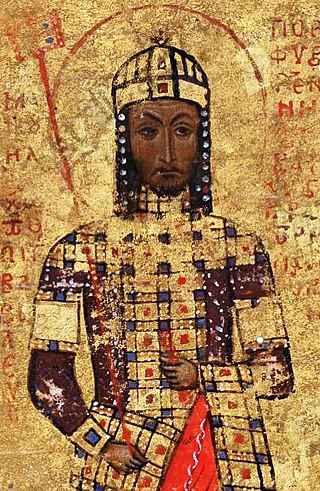
Manuel I Komnenos, Latinized Comnenus, also called Porphyrogennetos, was a Byzantine emperor of the 12th century who reigned over a crucial turning point in the history of Byzantium and the Mediterranean. His reign saw the last flowering of the Komnenian restoration, during which the Byzantine Empire had seen a resurgence of its military and economic power and had enjoyed a cultural revival.
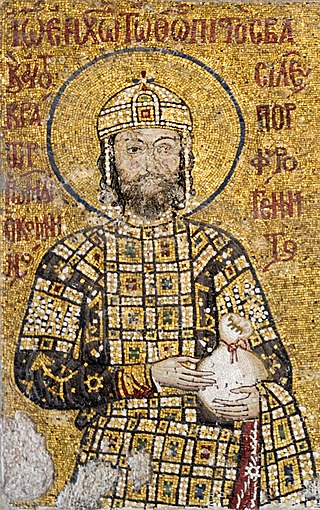
John II Komnenos or Comnenus was Byzantine emperor from 1118 to 1143. Also known as "John the Beautiful" or "John the Good", he was the eldest son of Emperor Alexios I Komnenos and Irene Doukaina and the second emperor to rule during the Komnenian restoration of the Byzantine Empire. As he was born to a reigning emperor, he had the status of a porphyrogennetos. John was a pious and dedicated monarch who was determined to undo the damage his empire had suffered following the Battle of Manzikert, half a century earlier.
The Battle of Myriokephalon was a battle between the Byzantine Empire and the Seljuk Turks in Phrygia in the mountains west of Iconium (Konya) in southwestern Turkey on 17 September 1176. The battle was a strategic reverse for the Byzantine forces, who were ambushed when moving through a mountain pass.
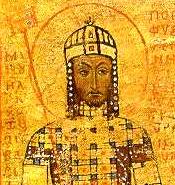
The Battle of Sirmium, Battle of Semlin or Battle of Zemun was fought on July 8, 1167 between the Byzantine Empire, and the Kingdom of Hungary. The Byzantines achieved a decisive victory, forcing the Hungarians to sue for peace on Byzantine terms. The battle consolidated Byzantine control of the western Balkans.
AlexiosBranas or Vranas was a Byzantine nobleman, attempted usurper, and the last Byzantine military leader of the 12th century to gain a notable success against a foreign enemy.

The Byzantine army of the Komnenian era or Komnenian army was a force established by Byzantine emperor Alexios I Komnenos during the late 11th/early 12th century. It was further developed during the 12th century by his successors John II Komnenos and Manuel I Komnenos. From necessity, following extensive territorial loss and a near disastrous defeat by the Normans of southern Italy at Dyrrachion in 1081, Alexios constructed a new army from the ground up. This new army was significantly different from previous forms of the Byzantine army, especially in the methods used for the recruitment and maintenance of soldiers. The army was characterised by an increased reliance on the military capabilities of the immediate imperial household, the relatives of the ruling dynasty and the provincial Byzantine aristocracy. Another distinctive element of the new army was an expansion of the employment of foreign mercenary troops and their organisation into more permanent units. However, continuity in equipment, unit organisation, tactics and strategy from earlier times is evident. The Komnenian army was instrumental in creating the territorial integrity and stability that allowed the Komnenian restoration of the Byzantine Empire. It was deployed in the Balkans, Italy, Hungary, Russia, Anatolia, Syria, the Holy Land and Egypt.
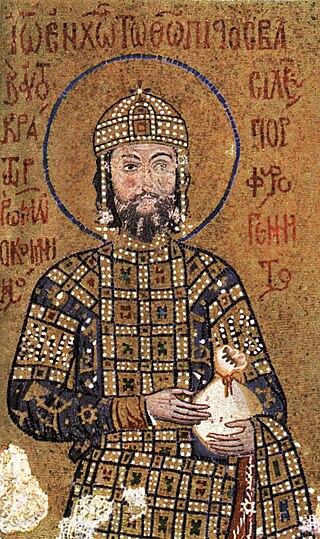
The Battle of Beroia was fought in 1122 between the Pechenegs and the Byzantine Empire under Emperor John II Komnenos in what is now Bulgaria. The Byzantine army won the battle, resulting in the disappearance of the Pechenegs as a distinct, independent people.

The Byzantine Empire was ruled by emperors of the Komnenos dynasty for a period of 104 years, from 1081 to about 1185. The Komnenian period comprises the reigns of five emperors, Alexios I, John II, Manuel I, Alexios II and Andronikos I. It was a period of sustained, though ultimately incomplete, restoration of the military, territorial, economic and political position of the Byzantine Empire.
John Axouch or Axouchos, also transliterated as Axuch was the commander-in-chief of the Byzantine army during the reign of Emperor John II Komnenos, and during the early part of the reign of his son Manuel I Komnenos. He may also have served as the de facto chief of the civil administration of the Byzantine Empire.
The Battle of Hyelion and Leimocheir saw the almost complete destruction by the Byzantines of a large Seljuq Turk army. The Seljuq army had been raiding Byzantine territory in the Maeander Valley in Anatolia, and had sacked a number of cities. The Byzantine force ambushed the Turks at a river crossing.
Andronikos Komnenos Kontostephanos, Latinized Andronicus Contostephanus, was a major figure in the Byzantine Empire during the reign of his uncle Manuel I Komnenos as a general, admiral, politician and a leading aristocrat.
Baldwin of Antioch was a Frankish knight and general in service of the Byzantine Empire during the Byzantine–Seljuk Wars. He was the son of Princess Constance of Antioch and Raymond of Poitiers. His brother-in-law was Byzantine Emperor Manuel I Komnenos. An ally of the Emperor in his battles against the Seljuk Turks, Baldwin was one of his most trusted advisors and the only one of Manuel's senior commanders "of Western origin".
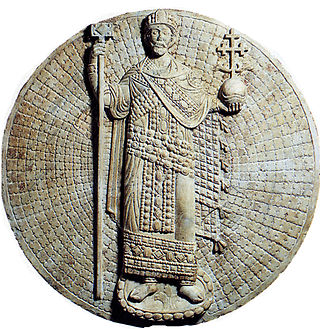
The Battle of Haram or Chramon was fought between the forces of King Stephen II of Hungary and Emperor John II Komnenos of the Byzantine Empire in the year 1128, or possibly earlier – in 1125, in what is now Serbia, and resulted in a major defeat for the Hungarians.
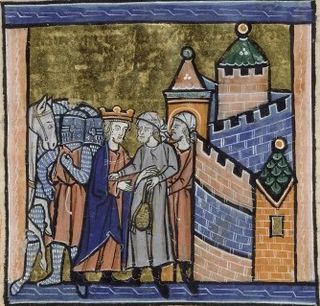
The siege of Shaizar took place from April 28 to May 21, 1138. The allied forces of the Byzantine Empire, Principality of Antioch and County of Edessa invaded Muslim Syria. Having been repulsed from their main objective, the city of Aleppo, the combined Christian armies took a number of fortified settlements by assault and finally besieged Shaizar, the capital of the Munqidhite Emirate. The siege captured the city, but failed to take the citadel; it resulted in the Emir of Shaizar paying an indemnity and becoming the vassal of the Byzantine emperor. The forces of Zengi, the greatest Muslim prince of the region, skirmished with the allied army but it was too strong for them to risk battle. The campaign underlined the limited nature of Byzantine suzerainty over the northern Crusader states and the lack of common purpose between the Latin princes and the Byzantine emperor.
John Komnenos Vatatzes, or simply John Komnenos or John Vatatzes in the sources, was a major military and political figure in the Byzantine Empire during the reigns of Manuel I Komnenos and Alexios II Komnenos. He was born c. 1132, and died of natural causes during a rebellion he raised against Andronikos I Komnenos in 1182.
Andronikos Angelos Doukas was a Byzantine aristocrat related to the ruling Komnenos dynasty. During the reign of his cousin, Manuel I Komnenos, he served without success as a military commander against the Seljuk Turks, and as envoy to the Kingdom of Jerusalem. Following Manuel's death, in 1182 he was sent to stop the rebellion of Andronikos I Komnenos, but was defeated and eventually defected to him. Shortly after, he led a failed conspiracy of leading aristocrats against Andronikos I. When it was discovered, Andronikos and his sons fled the Empire, ending up in Acre, where he died. He was the father of emperors Isaac II Angelos and Alexios III Angelos.
Stephen Kontostephanos was a Byzantine aristocrat and military commander.
A Byzantine–Hungarian War was fought between Byzantine and Hungarian forces on the Danube between 1127 and 1129. Byzantine primary sources, Cinnamus and Choniates, give little detail about this campaign; no dates are specified, and what they do say differs considerably.
The siege of Sozopolis saw the Byzantine conquest of the Seljuk Turk-held town of Sozopolis in 1120, improving Byzantine communications with the city of Attaleia.
The Byzantine–Hungarian War was a series of border conflicts between the Byzantine Empire and the Kingdom of Hungary that took place in the Balkans from 1149 to 1155. The conflict was affected by international disputes in Europe, primarily between Manuel I Komnenos and Roger II of Sicily, starting in the 1140s. The war broke out when Géza II of Hungary provided military assistance to the Serbs of Rascia (Raška), who rebelled against Byzantine suzerainty. The conflict ended with a peace treaty that restored the status quo ante bellum and established peace for five years. In 1161, the parties agreed to extend the truce for ten years but the relationship between them remained hostile, causing further clashes throughout the 12th century.









